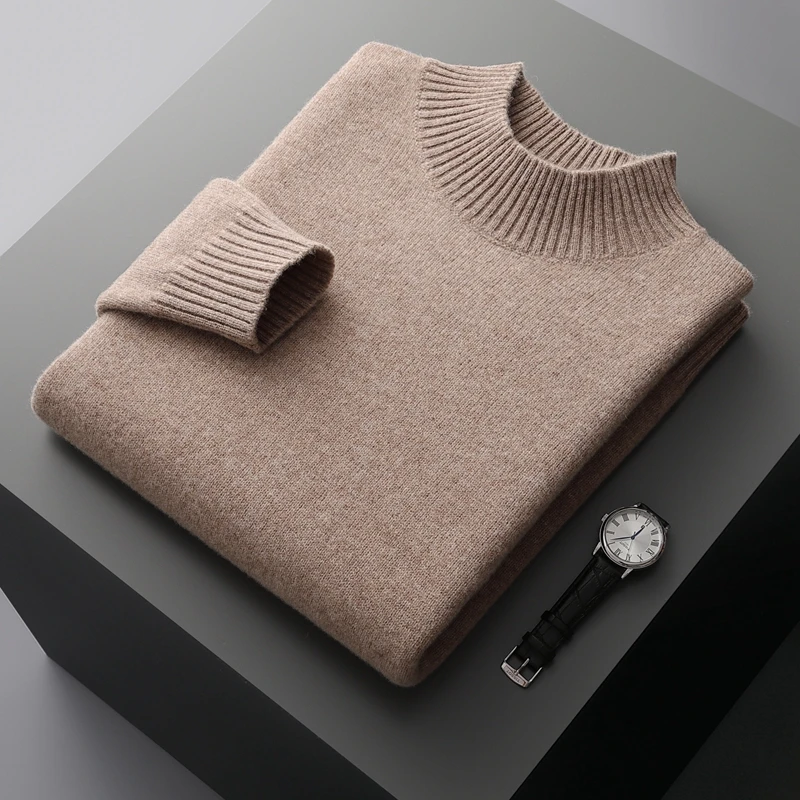Cashmere has long been synonymous with luxury, comfort, and timeless style. This premium fabric offers incredible versatility across seasons when you understand the important differences between thick and thin varieties. Estate Cloth brings you this comprehensive guide to help you make informed choices about cashmere thickness and enjoy this exquisite material throughout the year.
Understanding Cashmere Thickness: The Key Metrics That Matter
When exploring the world of cashmere, thickness is a fundamental quality that affects everything from warmth to styling options. Three primary measurements determine how thick or thin your cashmere garment will be:
- Ply Count: The number of yarn strands twisted together to form a single thread
- Gauge Number: The number of stitches per inch in the knitted fabric
- Yarn Count (Nm): A measure of yarn fineness based on length per weight unit
These metrics work together to create cashmere’s distinctive properties. For instance, a 4-ply cashmere sweater with a low gauge number will feel substantially heavier and warmer than a 1-ply, high-gauge cashmere t-shirt. Understanding these differences helps you select the perfect cashmere piece for any occasion.
The quality of the cashmere fiber itself is another crucial consideration. Premium cashmere, like Grade A fibers under 16 microns in thickness, provides superior softness regardless of whether the garment is thick or thin. The styling versatility of cashmere cardigans demonstrates how different thickness options can adapt to various looks and seasons.
Ply Count: The Foundation of Cashmere Warmth
Ply count refers to the number of yarn strands twisted together to create a single thread. This fundamental characteristic directly impacts the warmth, durability, and overall performance of your cashmere garment.
Common ply counts and their characteristics include:
- 1-ply: Extremely lightweight and breathable; ideal for warmer weather or indoor wear; less durable than higher plies
- 2-ply: The most versatile option; offers good warmth while maintaining lightness; standard for quality everyday cashmere
- 3-ply: Substantially warmer with increased durability; excellent for colder climates while maintaining elegant drape
- 4-ply and above: Maximum warmth and insulation; creates substantial, luxurious garments ideal for extreme cold; approximately twice the insulation of 2-ply
Higher ply counts naturally add weight to a garment, but quality cashmere maintains a relatively light feel even at 4-ply or higher. The increased thickness also improves durability and longevity, making higher-ply cashmere potentially more cost-effective over time despite the higher initial price.
For cold-weather staples like cashmere turtlenecks, ply count becomes particularly important. A 3-ply or 4-ply turtleneck provides exceptional warmth for winter, while a 1-ply or 2-ply option works better for transitional seasons or layering.
Gauge Numbers: Understanding Knit Density and Texture
Gauge refers to the number of stitches per inch in a knitted fabric. Unlike ply count, gauge numbers have an inverse relationship with thickness—lower gauge numbers indicate thicker, chunkier knits, while higher gauge numbers create finer, more delicate fabrics.
| Gauge Number | Fabric Characteristics | Best For |
|---|---|---|
| 3-7GG | Very thick, chunky texture | Maximum warmth, statement pieces |
| 8-12GG | Medium weight, traditional sweater feel | Versatile daily wear, moderate temperatures |
| 14-18GG+ | Fine, lightweight, smooth surface | Layering, warmer weather, elegant drape |
The gauge significantly affects not only the appearance but also the functionality of your cashmere piece. Lower gauge fabrics (5GG) create that classic chunky knit with visible texture and substantial warmth, while higher gauge fabrics (16GG) produce an almost silky, fine surface that drapes beautifully.
Breathability also varies with gauge—higher gauge fabrics allow more airflow, making them comfortable even in slightly warmer temperatures. Lower gauge fabrics trap more air between fibers for superior insulation in cold conditions.
The distinctive textures of different gauge knits are showcased beautifully in cashmere cable knit sweaters, where the pattern’s definition is enhanced by the gauge selection.
Yarn Count (Nm): The Fineness Factor
Yarn count, often expressed as Nm (metric count), measures how many meters of yarn are in one gram of weight. This technical specification directly impacts the lightness, drape, and overall luxury feel of cashmere garments:
- Higher Nm numbers (e.g., 48Nm) indicate finer, lighter yarns
- Lower Nm numbers (e.g., 28Nm) indicate thicker, heavier yarns
Fine yarns with high Nm values create incredibly lightweight, breathable fabrics that still provide remarkable warmth—a testament to cashmere’s exceptional insulating properties. These finer yarns typically feel softer against the skin and create garments with elegant drape and movement.
Thicker yarns with lower Nm values produce more substantial fabrics with enhanced durability and structure. These yarns are ideal for creating pieces with more defined silhouettes and maximum warmth retention.
Understanding yarn count helps explain why cashmere feels so much lighter than wool while providing comparable or superior warmth. This knowledge is particularly useful when styling cashmere cardigans for versatile looks, as the yarn count affects how the garment layers with other pieces.
Thick Cashmere: Optimal Seasons and Temperature Ranges
Thick cashmere garments—typically those with 3+ ply construction and lower gauge numbers—shine in specific climate conditions:
- Ideal for temperatures below 40°F (4°C)
- Perfect for winter months in moderate to cold climates
- Excellent for windy conditions due to dense fiber structure
- Suitable for outdoor activities in cold weather
The substantial insulating properties of thick cashmere make it comparable to much heavier materials like traditional wool, but with significantly less bulk and none of the itchiness. This makes thick cashmere an excellent choice for cold-weather comfort without sacrificing style or freedom of movement.
In extremely cold regions, thick cashmere performs admirably as either an outer layer or a mid-layer under weather-resistant shells. Its natural temperature-regulating properties prevent overheating when moving between outdoor cold and indoor heating, a common challenge with synthetic insulating materials.
For those seeking year-round cashmere comfort, understanding these temperature ranges helps determine when to incorporate thicker pieces into your wardrobe rotation.

Thick Cashmere: Ideal Garment Types and Styling
Thick cashmere works exceptionally well in certain garment types that maximize its warmth and substantial feel:
- Chunky sweaters: Create dramatic silhouettes with significant warmth
- Turtlenecks: Provide neck protection in cold and windy conditions
- Heavy cardigans: Function almost as light outerwear in moderate climates
- Cable-knit designs: Showcase texture while adding additional insulation through the pattern
When styling thick cashmere, consider these approaches:
- Layer a 4-ply cashmere cardigan over a light cotton shirt for variable indoor/outdoor comfort
- Pair a chunky cashmere sweater with slim-fitting pants or jeans to balance proportions
- Use thick cashmere as a statement piece in neutral colors that highlight the luxurious texture
- Consider oversized fits for maximum comfort and contemporary style
Thick cashmere requires slightly different care than thinner varieties. The denser knit can take longer to dry after washing, and proper folding (never hanging) becomes even more important to prevent the heavier fabric from stretching out of shape.
The men’s cashmere turtlenecks collection offers excellent examples of how thick cashmere can be tailored into refined yet supremely warm garments for the coldest months.
Thin Cashmere: Optimal Seasons and Temperature Ranges
Thin cashmere garments—typically those with 1-2 ply construction and higher gauge numbers—offer remarkable versatility across multiple seasons:
- Perfect for temperatures between 50-70°F (10-21°C)
- Ideal for spring and fall transitional weather
- Excellent for cool summer evenings and air-conditioned environments
- Suitable for mild winter climates or indoor winter wear
The exceptional temperature-regulating properties of cashmere truly shine in lightweight garments. The fine fibers provide warmth when needed but remain breathable enough to prevent overheating—making thin cashmere one of the most adaptable luxury materials available.
This adaptability makes thin cashmere particularly valuable for travel, as a single lightweight piece can serve multiple functions across changing climates and situations. The natural moisture-wicking and odor-resistant properties further enhance its practicality for extended wear.
Exploring strategies for layering lightweight cashmere year-round can help you maximize the value and versatility of these pieces in your wardrobe.

Thin Cashmere: Ideal Garment Types and Styling
Thin cashmere excels in garment types that highlight its elegant drape and versatility:
- Fine sweaters: Create polished, professional looks with exceptional comfort
- T-shirts and tanks: Elevate casual wear with subtle luxury
- Wraps and scarves: Add warmth without bulk for variable conditions
- Cardigans: Perfect for layering in unpredictable weather
When styling thin cashmere, consider these approaches:
- Layer multiple thin cashmere pieces for adjustable warmth without bulk
- Incorporate into professional attire under blazers or suits for comfort and temperature regulation
- Use as base layers under thicker garments in colder weather
- Select fitted styles that showcase the elegant drape of fine cashmere
Thin cashmere requires gentle handling during care, as the delicate fibers can be more susceptible to snags. However, proper care will maintain its beauty for years of regular wear.
For warm-weather options, the short sleeve cashmere sweaters collection provides excellent examples of how lightweight cashmere can be appropriate even during milder seasons.
Cashmere Wrap Sweaters, Women's Cashmere Pullovers
$75.89 Select options This product has multiple variants. The options may be chosen on the product pageCashmere Cable Knit Sweaters, Women's Cashmere Pullovers
Price range: $111.82 through $112.93 Select options This product has multiple variants. The options may be chosen on the product pageCropped Cashmere Sweaters, Women's Cashmere Pullovers
$155.77 Select options This product has multiple variants. The options may be chosen on the product pageOversized Cashmere Sweaters, Plus Size Cashmere Sweaters, Women's V-Neck Cashmere Sweaters
$136.87 Select options This product has multiple variants. The options may be chosen on the product page- Price range: $108.11 through $130.03 Select options This product has multiple variants. The options may be chosen on the product page
Striped Cashmere Sweaters, Women's Cashmere Pullovers
$139.68 Select options This product has multiple variants. The options may be chosen on the product page
Does Quality Vary Between Thick and Thin Cashmere?
One of the most common misconceptions about cashmere is that thickness automatically indicates quality. This is not the case—both thick and thin cashmere can be either premium or poor quality, depending on the fibers used.
True cashmere quality is determined primarily by:
- Fiber length: Longer fibers (exceeding 36mm) create stronger, more pill-resistant garments
- Fiber fineness: Finer fibers (under 16 microns) provide superior softness and comfort
- Purity: The absence of other fibers and minimal guard hairs
- Manufacturing standards: Careful processing and knitting techniques
Grade A cashmere can be crafted into both gossamer-light summer cardigans and substantial winter sweaters—the thickness is simply a design choice for different purposes. In fact, creating extremely fine yet durable cashmere often requires the highest quality raw materials and most skilled manufacturing.
When evaluating quality across thickness types, look for signs like an even knit, resilience when gently stretched, and a soft hand-feel without excessive initial shedding. These indicators of quality apply regardless of whether you’re examining a lightweight wrap or a chunky turtleneck.
For examples of quality across different thicknesses, explore our collection of cashmere sweaters that showcase various weights and constructions.
How to Choose Between Thick and Thin Cashmere for Your Needs
When deciding between thick and thin cashmere, consider these practical factors:
- Your local climate: Four-season regions benefit from both thick and thin options; milder climates may need only lightweight pieces
- Indoor environment: Well-heated buildings may make thick cashmere uncomfortable for extended indoor wear
- Personal temperature sensitivity: Those who run warm often prefer thinner cashmere even in cooler weather
- Intended use: Professional settings typically favor finer gauge pieces; casual and outdoor settings may benefit from thicker options
- Layering plans: Thin cashmere works better in layered outfits; thick cashmere often stands alone
For optimal versatility, consider building a complementary collection that includes:
– One thick statement piece (like a chunky cardigan or turtleneck)
– Several mid-weight versatile pieces (2-ply sweaters or cardigans)
– A few fine-gauge options for layering (tanks, t-shirts, or lightweight wraps)
This approach provides maximum wear opportunities across seasons and situations, optimizing the value of your cashmere investment. For additional ideas on maximizing versatility, our ultimate guide to layering cashmere cardigans offers practical advice.

Essential Care Tips for All Cashmere Thickness Types
Regardless of thickness, all cashmere requires proper care to maintain its beauty and longevity:
- Washing: Hand wash in cold water with mild detergent or cashmere shampoo; press water out gently without wringing
- Drying: Lay flat on a towel away from direct heat or sunlight; reshape while damp
- Storage: Always fold (never hang) to prevent stretching; store clean in breathable containers with cedar or lavender to deter moths
- Pilling management: Remove pills gently with a cashmere comb or fabric shaver; some initial pilling is normal and diminishes with time
Specific considerations for different thickness types:
- Thick cashmere may take significantly longer to dry; ensure complete drying before storage
- Thin cashmere requires extra care when washing to prevent stretching or tearing
- All cashmere benefits from rest between wearings to allow fibers to recover their shape
With proper care, quality cashmere can last for many years, making it not just a luxury purchase but a long-term investment in your wardrobe. These care recommendations apply to all garments, including our plus-size cashmere sweaters that offer inclusive sizing without compromising on quality.
By understanding the differences between thick and thin cashmere and selecting the right pieces for your lifestyle, you can enjoy the unparalleled comfort and elegance of this exceptional material throughout the year. Whether you choose substantial warmth for winter or lightweight elegance for spring, quality cashmere adapts beautifully to every season.







